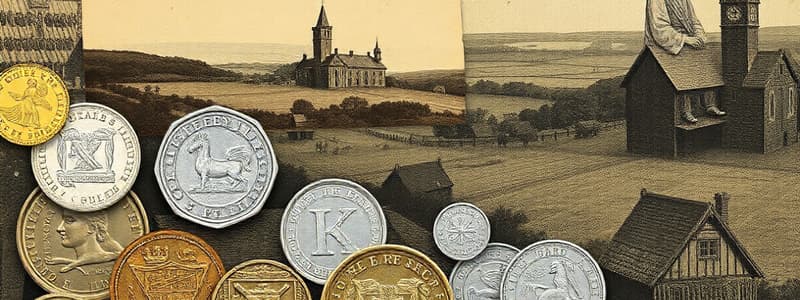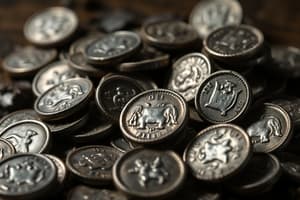Podcast
Questions and Answers
In what year did Adam Staples and his friends discover the Chew Valley Hoard?
In what year did Adam Staples and his friends discover the Chew Valley Hoard?
- 2024
- 2019 (correct)
- 2010
- 2016
What historical event immediately preceded the minting of the Chew Valley Hoard coins?
What historical event immediately preceded the minting of the Chew Valley Hoard coins?
- The Battle of Hastings (correct)
- The Roman Invasion of Britain
- The War of the Roses
- The Viking Raids on Wessex
Which of the following best describes why experts believe the Chew Valley Hoard was buried?
Which of the following best describes why experts believe the Chew Valley Hoard was buried?
- For safekeeping during a time of rebellion and conflict. (correct)
- As a component of a long-forgotten trade agreement.
- To conceal the location of a royal treasury.
- As part of a religious offering to ancient gods.
Approximately how much money did Adam Staples receive for his part in the discovery of the Chew Valley Hoard?
Approximately how much money did Adam Staples receive for his part in the discovery of the Chew Valley Hoard?
What practice, common in ancient times, is evidenced by some of the coins found in the Chew Valley Hoard?
What practice, common in ancient times, is evidenced by some of the coins found in the Chew Valley Hoard?
Based on Gareth William's estimation, what could the Chew Valley Hoard have been worth at the time it was buried?
Based on Gareth William's estimation, what could the Chew Valley Hoard have been worth at the time it was buried?
If the South West Heritage Trust decides to deaccession a single coin from the Chew Valley Hoard in the future, and assuming numismatic value increases at a rate of approximately 3% compounded annually, what would be the estimated value of that coin 20 years after its purchase?
If the South West Heritage Trust decides to deaccession a single coin from the Chew Valley Hoard in the future, and assuming numismatic value increases at a rate of approximately 3% compounded annually, what would be the estimated value of that coin 20 years after its purchase?
Imagine that a rival metal detectorist, upon hearing of the Chew Valley Hoard's discovery, thoroughly researches period land ownership records and discovers documentation suggesting their ancestor was the rightful owner of the field in 1066, dispossessed during the Norman Conquest. Assuming this evidence is admissible in modern court and property rights are successfully transferred, who would be entitled to the landowner's share of the hoard's value?
Imagine that a rival metal detectorist, upon hearing of the Chew Valley Hoard's discovery, thoroughly researches period land ownership records and discovers documentation suggesting their ancestor was the rightful owner of the field in 1066, dispossessed during the Norman Conquest. Assuming this evidence is admissible in modern court and property rights are successfully transferred, who would be entitled to the landowner's share of the hoard's value?
Flashcards
Chew Valley Hoard
Chew Valley Hoard
A collection of 2,584 silver pennies discovered in Chew Valley, England, dating back to the 11th century (1066-1068).
Discoverers of the Hoard
Discoverers of the Hoard
Adam Staples and friends discovered the Chew Valley Hoard in January 2019 using metal detectors.
Purchase of the Hoard
Purchase of the Hoard
The South West Heritage Trust purchased the Chew Valley Hoard for $5.5 million in October 2024.
Era of the Coins
Era of the Coins
Signup and view all the flashcards
Rulers on the Coins
Rulers on the Coins
Signup and view all the flashcards
Reason for Burial
Reason for Burial
Signup and view all the flashcards
Cut Coins
Cut Coins
Signup and view all the flashcards
Value of the Hoard
Value of the Hoard
Signup and view all the flashcards
Study Notes
- In January 2019, Adam Staples and his friends discovered a trove of silver coins in Chew Valley, Somerset, England, while testing a new metal detector.
- The find is now known as the Chew Valley Hoard.
- The Chew Valley Hoard consists of 2,584 silver pennies dating back to the 11th century.
- On October 23, 2024, the South West Heritage Trust acquired the Chew Valley Hoard for $5.5 million.
- The find is Britain’s most valuable treasure discovery to this date.
- Staples and his friends will receive half of the money ($400,000 each), and the landowner will receive the other half (approximately $2.8 million).
- The coins date from 1066 to 1068 and were minted at 46 different locations in England.
- The coins represent a crucial period in English history after the Norman Conquest of 1066, which led to the death of King Harold II.
- Approximately half of the coins depict King Harold, and the other half depict William I, who ruled England until 1087.
- Experts suggest the coins were buried for safekeeping.
- Amal Khreisheh, curator of archeology at South West Heritage, believes the coins were hidden against the backdrop of the rebellion against William in 1068 and attacks by Harold's sons.
- Some coins are cut in half, which was a common practice to create smaller denominations.
- Gareth Williams, a curator at the British Museum, estimates the Chew Valley Hoard's value at around 500 sheep or the annual income of a large estate.
- The Chew Valley Hoard will be exhibited in museums across the UK, starting at the British Museum in London in November 2024.
- The coins will be permanently housed at the South West Museum of Somerset.
Studying That Suits You
Use AI to generate personalized quizzes and flashcards to suit your learning preferences.





